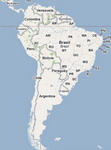Travel Guide to Chile:
5
Fun Facts to Know About Chile
A
Hiking Guide to Easter Island
Chile:
Land of Poets
Chile
Travel: Visiting the Lake District from Puerto Varas
Chile
Travel Destinations & Places To Visit in Chile
Concepcion
Guide
Discover
the beauty of San Pedro de Atacama
History
and Growth of Santiago de Chile
History
of Chile
Sightseeing
in Punta Arenas - Chile
Revealing
the Valleys of Chile
Swept
Away In Santiago De Chile
The
Mythology of Easter Island
Travel
to Valparaiso, Chile
History and Growth of Santiago
de Chile by Hortense Soulier
Browse
accommodation in Santiago
Santiago de Chile, capital
of Chile, is arguably one of the most attractive capitals in Latin and
Central America. Far from the chaos found in most major cities on the continent,
such as Lima or Mexico, Santiago is a beautifully city, modern, extremely
well maintained with great infrastructures, and countless attractions to
keep visitors entertained for days.

The city also boasts a fascinating
history, and has grown through the ages to become what it is now, the center
of all culture, economics, and politics in Chile. Santiago was founded
in February 1541 by Pedro de Valdivia, on the site of a former indigenous
settlement between the southern bank of the Rio Mapocho and the Cerro Santa
Lucia. This strategic location also makes for a magical backdrop, with
the city dominated by the nearby Andean range.
At first, Santiago was far
from a major hub, and was only one of the many Spanish administrative and
cultural outposts in the colonial period. Some other important centers
in the era include Concepcion in the South and La Serena in the north of
the country. Nevertheless, the city continually grew and evolved to become
one the main centers, with 12 churches built by the mid-17th century -
only one of which survived the devastating earthquake that destroyed most
of Santiago in 1618). Another massive earthquake was responsible for extensive
destruction in 1730.
The city started taking on
its role as a leading center for culture and politics after Chile declared
its independence form the Spanish Crown. In the 1870's, under the Indente,
or regional governor, Benjamin Vicuna MacKenna, the city was entirely redesigned.

An urban plan was drafted,
transforming Cerro Santa Lucia into a public park and building tramway
lines for public transportation.
The Chilean elite also started
settling in the city, with the wealthy from mining and shipping building
mansions in the western part of Santiago. Most colonial buildings were
gradually replaced throughout the 20th century as the city modernized itself
and grew ever more rapidly by the end of the century.
Like most Latin American
capitals, Santiago underwent massive expansion, but the city has somehow
managed to control this enormous growth and make Santiago one of the most
modern metropolitan areas on the continent.
Extensive suburbs, dozens
of shopping malls, and impressive sky scrapers fill the city. The transportation
infrastructure is also extremely modern, with a well organized bus system
as well as an underground Metro.
Browse
accommodation in Santiago
Top
|








